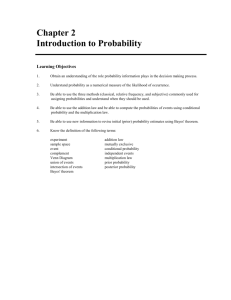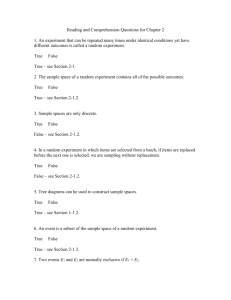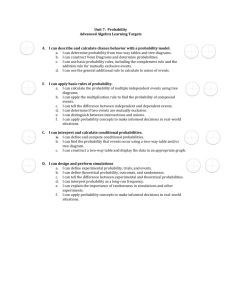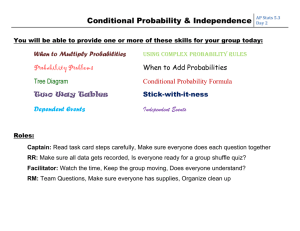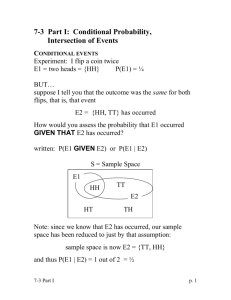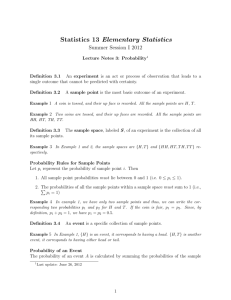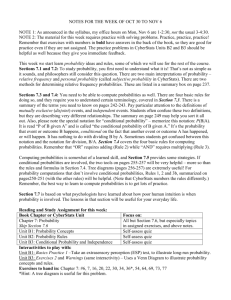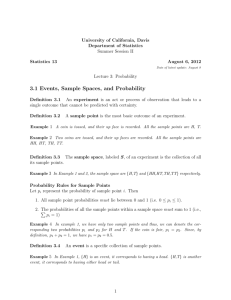Chapter 5 Multiple Choice Practice
advertisement
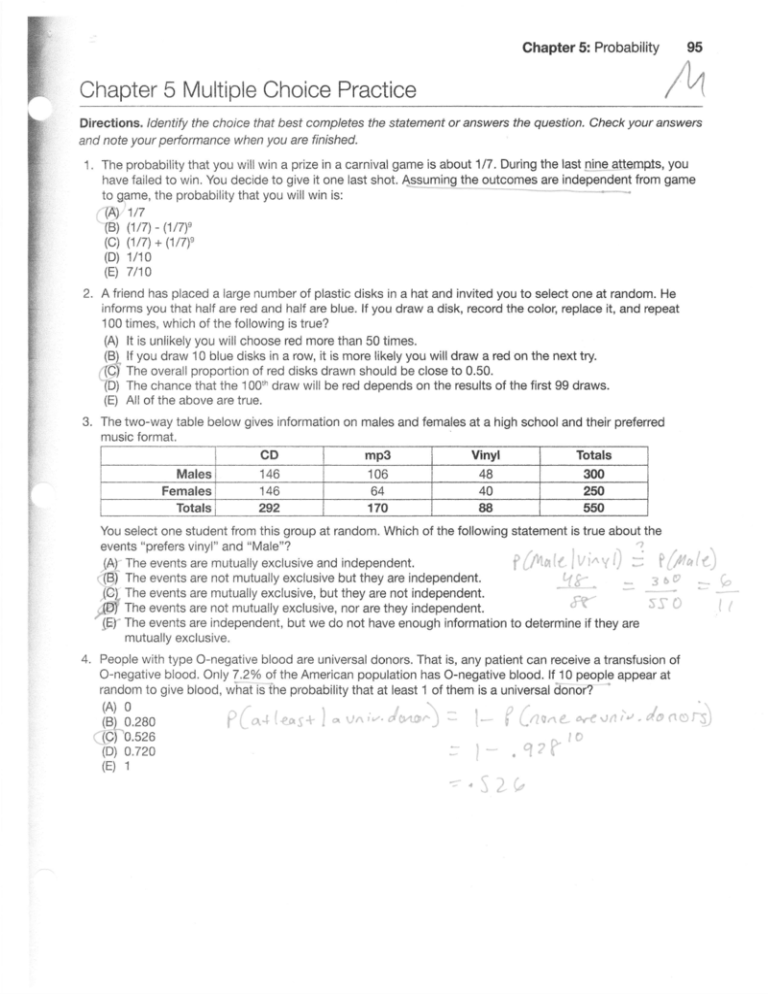
Chapter 5: Probability
95
1
;1,,n
/vt
/\
Chapter 5 Multiple Choice Practice
Directions. ldentify the chaice that best completes the statement or answers the question. Check your answers
and note your pertormance when you are finished.
1.
The probability that you will win a prize in a carnival game is about 1/7. During the last nine attempts, you
have failed to win. You decide to give it one last shot. Assuming the outcomes are independent from game
to game, the probability that you will win is:
(A) 1/7
{B) (1/7) - (1/7)'
(C) (1t7) + (1/7)'g
(D) 1/10
(E) 7/10
2.
A friend has placed alarge number of plastic disks in a hat and invited you to select one at random. He
informs you that half are red and half are blue. lf you draw a disk, record the color, replace it, and repeat
100 times, which of the following is true?
(A) lt is unlikely you wiil choose red more than 50 times.
(B) lf you draw 10 blue disks in a row, it is more likely you will draw a red on the next try.
(C) The overall proportion of red disks drawn should be close to 0.50.
(D) The chance that the 100ih draw will be red depends on the results of the first 99 draws.
(E) All of the above are true.
3. The two-way
table below gives information on males and females at a high school and their preferred
music format.
Males
Females
Totals
CD
mp3
Vinyl
Totals
146
106
48
300
146
64
4A
2N
292
170
88
550
You select one student frorn ihis group at random. Which of the following statement is true about the
events "prefers vinyl" and "Male"?
(A)Theeventsaremutuallyexclusiveandindependent.
(B) The events are not mutually exclusive but they are independent.
(C) The events are mutually exclusive, but they are noi independent.
_(Dj The events are not mutually exclusive, nor are they independent.
(E) The events are independent, but we do not have enough information to determine if they are
mutually exclusive.
4.
Peopie with type O-negative blood are universal donors. That is, any patient can receive a transfusion of
O-negative biood. An$ 7.2% of the American population has O-negative blood. If '10 people appear at
random to give blood, what is the probability that at least 1 of them is a universal donor?
(A) 0
(B) 0.280
(c) 0.526
(D) 0.720
(E)
1
Strive for a 5: Preparing for the
96
()
2/3
6?
h-
Pl.l) +f 'l-T-) -\
i r)*. r -"t'"*
f"t} { r/si*/d'e}
}L
sua
(D) 1/3
{E) 1t4
6.
P
"l \d "{ 3 X. =' *PX
t- Y' {- )r' 'i'
t
r,
lt
l/!k - 'r'{- * Y&- + .n, + l* * lF = !6 :' '
(B\ 1/2
LIS
Statistics Examination
6 comes up three times as often as any other number. What is the
5. A die is loaded so that the number
probability of rolling a 4, 5, or
AP@
You draw two candies at random from a bag that has 20,red, 19glepn, 15 orange, and 5 blue candies
is the probability that both candies are red?
Y*lre-Vl-f'-eelgg.e{9$rWhat
T, ?L?.,11 : -,lSSl
t{t q
5s
ic)a.zzzz
0.4444
(D)
(E)
7.
I
0.8000
An event A will occur with probability 0.5. An event B willoccur with probability 0.6. The probability that
.
un.d witt occur is
T-^dtf*Jr^-{
&*
?
{i./+.}
B
independent.
Events
A
and
are
,',
4$-t
0.1.
,. ?:yl
''
{
qr
rrs
L+lef EventsAaldBaremutuallyexclusive.
r"-\
-)i
(Q Either A^ or B always occurs.-'** - !r ,f-^***s_
/4Tf;F.
are.complementary. '
Events
,p|
L.und.B
i L.J-*- :.s :
.t--*-:------. " *,-j
(E) None of the above is correct.
d
d_*n
.flJlj .J,f
r. q'\
*-'/ril 'i
!! !''' L- f,\
;
, L4 .r
*
.{ +. 5 : i
Event A occurs with probability 0.8. The conditional probability that event B occurs, given that A occurs, is
0.5. The probability that both A and B occur
is:
(A) 0,3
(Ff
o.a
(c)
0.625
(D) 0.8
ir
iti lni
,e
kj
=-
,
f""
f { fi ip} = ,.5
Pi.* nA}::
-'
(E) 1.0
9.
At Lakeville South High School,60%o of students have high-speed internet access, 30% have a mobile
computing device, and 2Ao/o have both. The proportion of students that have neither high-speed internet
access nor a mobile computing dev_ice-is:
r "-,----*
i ,''"fr ,' ] ;,-.i {..1 .'
o%
(BJ 10%
flOrgOX
(D) B0%
(A)
,
'i
i_---)_-_
(E) e0%
-_
:
I
l
,
,3J
10. Experience has shown that a certain lie detector willshow ?gg-sjlryg*r-qggjlE Otc_qles a lie) 10% of
95% of the tifie-w-hen:a peison EliliiglSuF0asetn-m a
Jh*lfg_yhgl€ person is telling the truth and
nenfien-#mdgffisusirdfitii i5 subTefieh to a lie detector test regarding a recent one-person crime. The
readings if all suspects plead innocent and are telting the truth is:
probability of
(A) 0.40e
(B) 0.735
-'St,r r-s '$f .' :"''r {T .! l^ *i<^
il
., I '.ll,t,
'
i.! .
(c] 0.00001
'
ri-'
'rn1 . ,. .'
-i ;
br\'{ ,:
1<.+;,1 f.)
(Doo.sgr
,d
5="
(en
(E) 0.geeee
I t-*- , i".r*.""4
f
n\ <
.-i .i v--,
v
-
....i
ii
i
t
, i
:
* i,
. ':-j
i,,,-if
a
I
s8
strive for a 5: Preparing for the
AP@
Statistics Examination
After You Read: Check for Understanding
Concept 1: Probabitity Modets and the Basic Bules of Probability
Chance behavior can be described using a probability model. This model provides two pieces of
information: a list of possible outcomes (samplespace) and the likelihood of each outcome. Bydescribing
particular outcome
chance behavior with a probability model, we can find the probabitity of an event-a
probability:
probability
of
rules
models must obey some basic
or collection of outcomes.
,'''"o
Far any event A, 0 < P(4 < 1 .
lf S is the sample space in a probability model, P(S) = 1'
ln the case of equaily likely outcomes, P(A) = {# outcomes in event A\
r
,' o
*" :'
j--" 'P(Ac)=1-P{AL
.
/ (# outcomes
in Q.
lf A and B are mutually exclusive events, P(A or B) = P(A) + P(B).
and apply
After this section, you should be able to describe a probability model for chance behavior
events.
the basic probability rules to answer questions about
can describe a probability modelfor a chanc-e process and
ru{e for mutually exclusive
can use basic probability /ules s'uch as the complement rule and addition
evenfs
checkfor understanding:
-l
-t
Consider drawing a card from a shuf{led fair deck of 52 playing cards'
process? What's the
1. How many possible outcomes are in the sample space for this chance
probability for each outcome?
-:;;;:
'*'* * 5: U:t.T.*t'*-t;""*I{'
-1 i":
t.}
!a+'r
e'''1*
&
i1ai
-t*
L.
fsptfr
[}#il
str\
"
f
TE..e
o'*r
*rJ-l
Define the following events:
A: the card drawn is an Ace
B; the card drawn is a heaft
2. Find P(A)and P(B).
'^.'
t':/i';"
i. r-e .-'
t'.r.t
Ll
'r-.,
1r
.
.,
, *r
-^ gl :?
.,
.r.:'ri6-j
"h
-'i
',--
1
3. What is P(Ac)?
,
\
nAl
.-l'
,r.iL t'
:t" '--'
:.: #, Q
?.-3,,'r
Chapter 5: Probability
89
Concept 2 Two-Way Tables and Venn Diagrams
Often we'll need to find probabilities involving two events. ln these cases, it may be hetpfulto organize
and display the sample space using a two-way table or Venn diagram. This can be especially helpful
when two events are not mutually exclusive. When dealing with two events A and B, it is important
to be able to describe the union (or collection of all outcomes in A, 8, or both) and the intersec]ion
wi\
upon the Dastc rutes
(the collection ql
Ltq*"'.'"
v-.
&:ffi;"tiontohelpusfindtheprobabilityoftwoeventsthatarenotmutuallyexclusive.
C.
llA and B aretwo events
, P(A
v
B) = P(A) + P(B) -
P(A^
Bl.J
_l
can use a Venn diagram to model a chance process
I can find the probability of an event using a two-way table, and
can use the general addition rule to calculate P(A U B)
Check for Understanding:
involving two
events,
-l
Consider drawing a card from a shuffled fair deck of 52 playing cards.
Define the following events:
A: the card drawn is an Ace
B; the card drawn is a heart
1. Use a two way table to display the sample space.
c-
t1
ra
sb
qq
lb
T'l*
I
t
2. Use a Venn diagram to display the sample space.
$
l,.t
3. Find P(A
F
v
{k,)
B). Show your work.
15\
- {fr n8}
?
ro
l!)
= fiA-{
l)
\i/,
u'/+
'::- o5 + ir z-
/s>
lvt
,1f )
'Jt-'
5* a,
3r:
??
Chapter 5: Probability
91
After You Read: Check for Understanding
Concept l: Conditional Probability and lndependence
A conditional probability describes the chance that an event will occur given that another event is
already known to have happened. To note that we are dealing with a conditional probability, we use
the symbol I to mean "given that." For example, suppose we draw one card from a shuffled deck of 52
playing cards. We could write "the probability that the card is an ace given that it is a red card as P(ace
I red). Building on the concept of conditional probabilities, we say that when knowing that one event
has occurred has no effect on the probability of another event occurring, the events are independent.
That is, events A and B are independent if P(A I B) = P(A)and P(B lA) = P(B). Note that the events "get
an ace" and "get a red card" described earlier are independent - if you know a randomly selected card
is red, the probability it is an ace is 2126. This is equal the same as the probability a randomly selected
card (regardless of colo$ is an ace. That is, 2/26 = 4/52. Likewise, if you know a randomly selected card
is an ace, the probability it is red is 1/2. This is the same as the probability a randomly selected card
(regardless of value) is red. Therefore, the two events are independent.
_
Check for Understanding:
I can compute conditional probabilities and
whether two events are independent
_
I can determine
ls there a relationship between gender and candy preference? Suppose 200 high school students
were asked to complete a survey about their favorite candies. The table below shows the gender of
each student and their favorite candy.
Male
M&M's 40
Total 12O
Skittles 80
Female
60
2A
80
Total
140
60
2AO
Define A to be the event that a randomly selected student is male and B to be the event that a
randomly selected student likes Skiftles. Are the events A and B independent? Justify your answer.
92
Strive for a 5: Preparing for the
AP@
Statistics Examination
Concept 2; Tree Diagrams and the Multiplication Rule
When chance behavior involves a sequence of events, we can model it using a tree diagram. A tree
diagram provides a branch for each outcome of an event along with the associated probabilities of those
outcomes. Successive branches represent particular sequences of outcomes. To find the probability of
an event, we multiply the probabilities on the branches that make up the event.
This leads us to the general multiplication rule: P(A n B) = P(A) . P(B I A).
"
lf A and B are independent, the probability that both events_occur.is P(A n B) = P{A) . P(B),"
Check for Understanding: _ I can use a tree diagram to describe chance behavior and
_ I can use the general multiplication rule to solve probability questrbns
A study of high school juniors in three districts
- Lakeville, Sheboygan, and Omaha - was conducted
to determine enrollment trends in AP mathematics courses-Calculus or Statistics. 42Yo of students
in the study came from Lakeville, ST%6 came from Sheboygan, and the rest came from Omaha. ln
Lakeville, 64% o'f juniors took Statistics and the rest took Calculus. 58% of juniors in Sheboygan and
49o/o of juniors in Omaha took Statistics while the rest took Calculus in each district. No juniors took
both Statistics and Calculus. Describe this situation using a tree diagram and find the probability that
a randomly selected student from in the study took Statistics.
Chapter 5: Probability
Concept 3: Calculating Conditional Probabilities
By rearranging the terms in the general multiplication rule, we can determine a rule for conditional
'using a two-way table, Venn diagram, or tree diagram. However, the formula can also be used if you
know the appropriate probabilities in the situation.
Check for Understanding:
_l
can compute conditional probabilities
Consider the situation from Concept 2.
Find P(student is from Lakeville ltook
Statistics). =
I Cr* heu
,_l
I
.. A 3+"&r{ '}D
Ptsr+,T+rb
(, q>)(, uq)
,5tb)
g,t4
S
f5
sJ
Strive for a 5: Preparing for the
262
AP@
Statistics Examination
Chapter 5: Probability
,S
X
C
'h
A
E
V
tc
U
o
U
M
N
L
B
D
*M
,A
A
,E
tN
,S
M
D
P
D
L
I
M
T
U
P
L
L
E
N
N
S
,h
L
A
U
C
S
E
R
o
B
A
B
o
V
E
,U
N
R
S
E
c
I
T
I
o
o
T
'b
L
I
T
N
D
S
E
o
P
N
E
C
S
A
N
A
J
L
D
T
o
E
,A
N
I
E
R
T
N
T
I
I
o
N
N
T
A
N
D
o
'l(/l
o
T
D
't
R
E
E
L
Across
8. The collection of outcomes that occur in both of
two events. INTERSECTION]
9. A collection of outcomes from a chance process.
lEVENrl
11. The propofiion of times an outcome would occur
in a very long series of repetitions.
IPROBABTLTTYI
12.
can be used to find probabilities
that require going "backward" in a tree diagram.
_Theorem
IBAYESI
13. ln statistics, this doesn't mean "haphazard." lt
means "by chance." [HANDOM]
15. The collection of outcomes that occur in either
of two events. IUNION]
16. A
diagram can help model chance
behavior that involves a sequence of outcomes.
_
lrREEl
Down
1. The law of
large
states that the
proportion of times an outcome occurs in many
repetitions will approach a single value.
INUMBERSI
2.The probability that one event happens given
another event is known to have happened.
lcoNDrTroNALl
3. The set of all possible outcomes for a chance
process (two words). [SAMPLESPACE]
4. The probability that two events both occur can
be found using the general
rule.
_
IMULTTPLTCATTONI
5. P(A or B) can be found using the general
rule. [ADDITION]
6. The imitation of chance behavior, based on a
model that reflects the situation. [SIMULATION]
7.The occurrence of one event has no effect on
the chance that another event will happen.
ITNDEPENDENTI
9. Another term for disjoint: Mutually
IEXCLUSTVEI
10. Two events that have no outcomes in common
and can never occur together. [DISJOINT]
AP Statistics Practice Test
(page 336)
T5.1 c. Probability only tells us what happens approximately in the long run, not what will happen in the
short run.
T5.2 d. You need exactly 62 of the 100 2-digit numbers to represent the event "having heard of Cocacola.''
T5.3 c. Add the probabilities for 3, 4 and 5 cars.
T5.4 b. AllZ-digit numbers among the first
10 are between 00 and 97 except 98.
T5.5 b. 255 of the 1000 students had a GPA below 2.
T5.6 c. There
are 285 students who either have a GPA below 2,have skipped many classes or both.
T5.7 e. There are 110 students who have skipped many classes. 80 of them have a GPA below 2.
T5.8 e. If A and B are independent, then we don't know whether B has occurred if A occurred. But if A
and B are mutually exclusive, then if B has occurred then we know that A couldn't have occurred.
T5.9 b. P(woman
L.,
never married) = P(woman)+ P(never manied)
-
P(woman
.
never married).
T5.10 c. We want P(first is picture n second is picture n third is picture) = fg.]f+)[*)
'
= 0.0,.
IszJIs r /[sol
T5.11 (a) Since each outcome is equally likely and there are 48 outcomes, each outcome has probability
a. th...
48
are 27
waysin which the teacher wins (all boxes above and to the right of the diagonal line
indicating ties). So the probability that the teacher wins is
r(at,e)=P(A)+r(n)-P(AnB).
get a3" so
From part(a),
448 fq
r(a)= !.
We use the fact that
Th"r"are8outcomesinwhich"you
f (e) = -.!- urd there are 5 outcomes in which "you roll a 3" and the teacher still wins so
Puttingall ofthistogethergives P(AuB)= +.+-+=+=:
r(anB)=+.
\/4ge\'4g4g4g4gg"
(b). we have P(A)
=#. ,tul: * ",0 P(A n B) : a.
r(a ne) =*-(#)t*)= r(a)r(e),
A and B
(c)
From part
sin..
are not independent.
T5.12 (a)
r30
The Practice of Statistics
/or AP*,4/e
0q
J9
, -0.!
c
99
<qe
Probability
Defective
0.06
oK
0.54
Defective
0,09
OK
0.21
Defective
0.04
oK
0.06
(b) To
get the probability that apart randomly chosen from all parts produced by this machine is
defective, add the probabilities from all branches in the tree that end in a defective paft.
P(defective) = 0.06 + 0.09 + 0.04 = 0.19. (c) First compute the conditional probabilities that the part was
produced on a parlicular machine given that it is defective
P(A ldefective) = +ry:0.3158.
'
0.19
r(cloerective)=901:0.210s.
P(Bldefectir.)=:?::0.4737.
\
\
'
' 0.19
sincethelargestofthesettuee
0.19
conditional probabilities is for machine B, given that a part is defective, it is most likely to have come
from machine B.
T5.
t3 (a)
p(gers cancer I smoker)
-
P(gets
:lncer
n
s-moker)
P(smoker)
=
qry 0.32.
=
(b) The event thar
an
0.25
individual either smokes or gets cancer is the complement of the event that the individual neither smokes
nor gets cancer. So
P(smokesurgetscancer)=1-P(doesnotsmokendoesnotgetcancer)=1-0.71 =0.29.
(c) First find the probability that one person gets cancer. From part (b) we know that
P(smokes u gets cancer) =0.29. But we also know that P(smokes) = 9.25 und
P(smokes n gets cancer) : 0.08. Now, using P(s u C) = r(s) + r(C) - P(S n C) we get
0.29=0.25+P(getscancer)-0.08. Solvingfor P(getscancer)weget0.12. Finally
P(at least one gets cancer) = 1* P(neither gets cancer) = 1-
0.88'z = 0.2256.
T5.la (a) Assign the numbers 01-17 to represent cars with out-of-state plates and the remaining 2-digit
numbers between 00 and 99 to represent other cars. Staft reading 2-digit numbers from a random number
table until you have found two numbers between 01 and 17 (repeats are allowed). Record how many 2digit numbers you had to read in order to get 2 numbers between 0 I and 1 7. Repeat many times for the
simulation. (b) The first sample is 41 05 09. The numbers in bold represent cars with out-of-state
plates. In this sample it took three cars to find two with out-of-state plates. The second sample is 20 3l
06 44 90 50 59 59 88 43 18 80 53 11. In this sample it took 14 cars to find two with out-of-state plates.
The third sample is 58 44 69 94 86 85 79 67 05 81 18 45 14. In this sample it took 13 cars to find two
with out-of-state plates.
Chapter 5: Probability: What Are the Chances?
l3l
